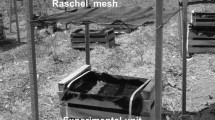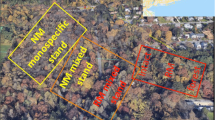Abstract
Ligustrum lucidum, a tree native to China has naturalized in Japan where it is often planted in parks and along roads. Naturalized individuals in urban woodlands have uncertain competitiveness against native species, particular in light of the frequent pruning undertaken in these woodlands. We compared fitness-related traits of Ligustrum against two co-occurring native species: a pioneer tree (Mallotus japonicus) and an understory tree (Eurya japonica) under pruned and un-pruned settings. A growth experiments where we assessed the leaf and whole plant characteristics of the 3 species under two environments simulating forest edge and forest interior, and two pruning treatments (with or without) was conducted. Under simulated forest edge without pruning, Ligustrum had lower stem growth and Amax (maximum photosynthetic rate) than Mallotus, suggesting that native species can competitively suppress invasive expansion. With pruning, however, Ligustrum resprouted vigorously in both spring and summer with significantly higher apical growth and total shoots than Mallotus and Eurya in forest edge and interior, respectively. Also, with similar Amax between resprouts of Ligustrum and Mallotus, we see a reversal of competitive advantage in favor of Ligustrum in forest edge. In the forest interior, Ligustrum exhibited shade tolerant properties (i.e., Amax, chlorophyll a/b, and leaf density) similar to Eurya but had more resprout shoots, suggesting that the invader also maintains an advantage under low light. The competitiveness of Ligustrum clearly increased with human disturbance in the form of park pruning. Such management practice can inadvertently enhance the invasiveness of exotic species in urban settings.



Similar content being viewed by others
References
Aguiar FCF, Ferreira MT (2013) Plant invasion in the rivers of the Iberian Peninsula, south-western Europe: A review. Plant Biosyst 147:1107–1119
Aguirre-Acosta N, Kowaljow E, Aguilar R (2014) Reproductive performance of the invasive tree Ligustrum lucidum in a subtropical dry forest: does habitat fragmentation boost or limit invasion? Biol Invasions 16:1397–1410
Aragón R, Groom M (2003) Invasion by Ligustrum lucidum (Oleaceae) in NW Argentina: early stage characteristics in different habitat type. Revista de Biología Tropical 51: 59–70 [online, accessed December 18, 2014]
Aslan CE, Rejmánek M (2010) Avian use of introduced plants: ornithologist records illuminate interspecific associations and research needs. Ecol Appl 20(4):1005–1020
Aslan CE (2011) Implications of newly-formed seed-dispersal mutualisms between birds and introduced plants in Northern California, USA. Biol Invasions 13:2829–2845
Aslan CE, Rejmánek M, Klinger R (2012) Combining efficient methods to detect spread of woody invaders in urban-rural matrix landscapes: an exploration using two species of oleaceae. J Appl Ecol 49(2):331–338
Augustine DJ, McNaughton J (1998) Ungulate effects on the functional species composition of plant communities: herbivore electivity and plant tolerance. J Wildl Manag 62:1165–1183
Averill KM, DiTommaso A, Mohler CL, Milbrath LR (2010) Establishment of the invasive perennial Vincetoxicum rossicum across a disturbance gradient in New York state, USA. Plant Ecol 211:65–77
Bond WJ, Midgley JJ (2001) Ecology of sprouting in woody plants: the persistence niche. Trends Ecol Evol 16:45–51
Bellingham PJ, Sparrow AD (2000) Resprouting as a life history strategy in woody plant communities. Oikos 89:409–416
Burke MJW, Grime JP (1996) An experimental study of plant community invasibility. Ecology 77:776–790
Chapin FS III, Schulze E-D, Mooney HA (1990) The ecology and economics of storage in plants. Annu Rev Ecol Syst 21:423–447
Charles-Dominique T, Edelin C, Bouchard A (2009) Architectural strategies of Cornus sericea, a native but invasive shrub of Southern Quebec, Canada, under an open or a closed canopy. Ann Bot-London 105(2):205–220
Blanchon D, Pusateri J, Galbraith M, Thorpe S (2011) Sampling indigenous ground-living beetles in a stand of non-native tree privet (Ligustrum lucidum) in New Zealand raises new management questions. Ecol Manag Restor 12:234–236
Delagrange S, Messier C, Lechowicz MJ, Dizengremel P (2004) Physiological, morphological and allocational plasticity in understory deciduous trees: importance of plant size and light availability. Tree Physiol 22:775–784
Fuentes-Ramírez A, Pauchard A, Cavieres LA, García RA (2011) Survival and growth of Acacia dealbata vs. native trees across an invasion front in south-Central Chile. For Ecol Manag 261:1003–1009
Gavier-Pizarro GIT, Kuemmerle T, Hoyos LE, Stewart SI, Huebner CD (2012) Monitoring the invasion of an exotic tree (Ligustrum lucidum) from 1983 to 2006 with Landsat TM/ETM + satellite data and support vector machines in Córdoba, Argentina. Remote Sens Environ 122:134–145
Gilbert B, Lechowicz MJ (2005) Invasibility and abiotic gradients: the positive correlation between native and exotic plant diversity. Ecology 86:1848–1855
Greenberg C, Smith L, Levey D (2001) Fruit fate, seed germination and growth of an invasive vine- an experimental test of ‘sit and wait’ strategy. Biol Invasions 3:363–372
Groves RH (1986) Plant invasion of Australia: an overview. In: Groves RH, Burden JJ (eds) Ecology of biological invasion. Cambridge University Press, Cambridge, pp. 137–149
Hayes KR, Barry SC (2008) Are there any consistent predictors of invasion success? Biol Invasions 10:483–506
Hashimoto Y, Hattori T, Ishida H, Toi K (2005) The alien plant Ligustrum lucidum escaping from planting sites to indigenous vegetation in Japan. Landsc Res J 68(5):713–716 (in Japanese)
Higo M (2002) Factors limiting fruit production in the understory shrub, Eurya japonica. Jpn J Ecol 52:1–9 (in Japanese)
Hoyos LE, Gavier-Pizarro GI, Kuemmerle T, Bucher EH, Radeloff VC, Tecco PA (2010) Invasion of glossy privet (Ligustrum lucidum) and native forest loss in the sierras chicas of Córdoba, Argentina. Biol Invasions 12:3261–3275
Hunt R (1982) Plant growth curves: the functional approach to plant growth analysis. Edward Arnold, London
Imanishi A (2006) Eurya japonica thumb. J Jpn Soc Revegetation Technol 32(2):374
Ito, C, Fujiwara K (2007) Habitat and ecological characteristics of the alien species Ligustrum lucidum ait. in urban forests in Japan – comparison with native Ligustrum species. Japanese Journal of Conservation Ecology12: 143–150 (in Japanese)
Kitamura S, Murata G (1971) Colored illustrations of woody plants of Japan, vol 1, revised edn. Hoikusha Publishing, Higashiosaka
Kohyama T (1987) Significance of architecture and allometry in saplings. Funct Ecol 1:399–404
Lichstein JW, Grau HR, Aragón R (2004) Recruitment limitation in secondary forests dominated by an exotic tree. J Veg Sci 15:721–728
Lorenzo P, Gonzales L, Reigosa MJ (2010) The genus Acacia as invader: the characteristic case of Acacia dealbata link in Europe. Ann For Sci 67(1):1–11
MacDougall AS, Gilbert B, Levine JM (2009) Plant invasions and the niche. J Ecol 97:609–615
Manabe T, Yamamoto S-I (1997) Spatial distribution of Eurya japonica in an old-growth evergreen broad-leaved forest, SW Japan. J Veg Sci 8:761–772
Myers JA, Kitajima K (2007) Carbohydrate storage enhances seedling shade and stress tolerance in a neotropical forest. J Ecol 95:383–395
NIES (National Institute for Environmental Studies) http://www.nies.go.jp/biodiversity/invasive/DB/toc8_plants.html Accessed September 10, 2014
National Institute for Land and Infrastructure Management (2004) NILIM Report No.146, Street trees of Japan V, pp 235
Nzunda EF, Griffiths ME, Lawes MJ (2008) Sprouting by remobilization of above-ground resources ensures persistence after disturbance of coastal dune forest trees. Funct Ecol 22:577–582
Nzunda EF, Griffiths ME, Lawes MJ (2014) Resource allocation and storage relative to resprouting ability in wind disturbed coastal forest trees. Evol Ecol 28:735–749
Osugi Y, Ishii H (2009) Different physiological and morphological responses of leaves and branches of Ligustrum japonicum and invasive L. lucidum to the light environment. J Jpn Soc Revegetation Technol 35(1):45–50 (in Japanese)
Panetta FD (2000) Fates of fruits and seeds of Ligustrum lucidum W.T.Ait. and L. sinense Lour. maintained under natural rainfall or irrigation. Aust J Bot 48:701–705
Porra RJ, Thompson WA, Kriedemann PE (1989) Determination of accurate extinction coefficients and simultaneous equations for assaying chlorophylls a and b extracted with four different solvents: verification of the concentration of chlorophyll standards by atomic absorption spectroscopy. Biochim Biophys Acta 976:384–394
R Core Team (2008) R: A language and environment for statistical computing. R Foundation for Statistical Computing, Vienna, Austria. URL http://www.R-project.org/.
Spooner PG, Lunt ID, Brigg SV, Freudenberger D (2004) Effects of soil disturbance from roadworks on roadside shrubs in a fragmented agricultural landscape. Biol Conserv 117:393–406
Swarbrick JT, Timmins SM, Bullen KM (1999) The biology of Australian weeds. 36. Ligustrum lucidum Aiton and Ligustrum sinense Lour. Pl Prot. Q 14:122–130
Valladares F, Niinemets U (2008) Shade tolerance, a key plant feature of complex nature and consequence. Annu Rev Ecol Evol S 39:237–257
van Kleunen M, Weber E, Fischer M (2010) A meta-analysis of trait differences between invasive and non-invasive plant species. Ecol Lett 13:235–245
Weber E (2003) Invasive plant species of the world. CABI Publishing, Wallingford, A reference guide to environmental weeds
Washitani I (2004) Invasive alien species problems in Japan: an introductory ecological essay. Global Environ Res 8(1):1–11
Washitani I, Murakami O (2002) Handbook of alien species in Japan. Chijinshokan, Tokyo
Washitani I, Takenaka A (1987) Gap-detecting mechanism in the seed germination of Mallotus japonicus (Thumb.) Muell. Arg., a common pioneer tree of secondary succession in temperate Japan. Ecol Res 2:191–201
Wilson JR, Yeates A, Schooler S, Julien MH (2007) Rapid response to shoot removal by the invasive wetland plant, alligator weed (Alternanthera philoxeroides). Environ Exp Bot 60(1):20–25
Yoshinaga C, Kameyama A (2001) Urban ecological study on expansion of glossy privet (Ligustrum lusicum ait.). J Jpn Soc Revegetation Technol 27(1):44–49 (in Japanese)
Acknowledgments
We thank the Otsu City Parks Department, and Ryuo Shrine, Goryo Shrine for their support and permission to conduct the field portion of the study. This work was supported by an operating grant from Ryukoku University.
Author information
Authors and Affiliations
Corresponding author
Rights and permissions
About this article
Cite this article
Lei, T., Nishikawa, N. & Yamashita, N. Park pruning prompts a competitive reversal of an exotic tree, Ligustrum lucidum, in urban forests of Japan. Urban Ecosyst 19, 1103–1118 (2016). https://doi.org/10.1007/s11252-016-0539-z
Published:
Issue Date:
DOI: https://doi.org/10.1007/s11252-016-0539-z




